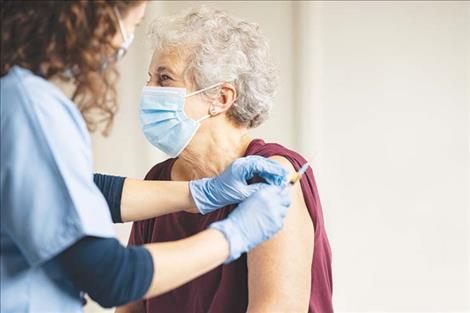Updates to COVID-19 vaccination distribution plan announced
Nearly 17,000 Montanans vaccinated in first couple weeks
Hey savvy news reader! Thanks for choosing local.
You are now reading
1 of 3 free articles.
News from the Office of the Governor
MONTANA — Outgoing Governor Steve Bullock recently announced the state’s COVID-19 vaccine distribution plan has been updated to incorporate the new federal recommendations for allocation to critical groups in Montana and includes an estimated timeline.
“As the first phase of Montana’s COVID-19 vaccination plan is fully under way, it’s inspiring to see that thousands of healthcare workers have already been vaccinated and that it’s now reaching staff and residents of long-term care facilities,” Bullock said. “As we continue to focus on vaccinating those most vulnerable to this virus, it is incumbent on all of us to keep our friends, neighbors and loved ones safe as we inch toward widespread distribution of the vaccine.”
The updated plan outlines an estimated timeline for vaccine distribution in phases 1a, 1b, 1c and then the last phase (phase two) when vaccines are expected to available to all Montanans late spring or early summer 2021. The estimated timeline covers December 2020 through July 2021 and lists which groups are recommended to receive the vaccine in each phase.
Currently, Montana has launched phase 1a that targets frontline healthcare workers and staff and residents of long-term care facilities. With a total of 16,990 healthcare personnel in Montana having now received their first vaccination dose, this phase is now being expanded to include additional healthcare workers with direct patient contact, such as dentists, orthodontists, physical therapists, optometrists, home health workers and others that fit the criteria.
The plan states that phase 1b will begin in mid-January and continue through March. Phase 1b includes an estimated 90,000 Montanans, such as persons aged 75 years old or older, frontline essential workers, those residing in congregate care and correctional facilities and American Indians and other people of color who may be at elevated risk for COVID-19.
Phase 1c is expected to launch in mid-March and continue through July and includes another 171,000 Montanans. Critical groups in phase 1c are those aged 65 years and older, persons aged 16-64 at high risk due to underlying medical conditions and essential workers.
The final phase is expected to launch in late spring or early summer for all Montanans ages 16 and older. Implementation of the plan is contingent on vaccine availability.
“It’s important to highlight that expansion to additional groups in phase 1a and phases later on will vary from community to community depending on vaccine availability and how quickly the vaccines are distributed,” said Bekki Wehner of the DPHHS Communicable Disease Control and Prevention Bureau. “DPHHS is working with local health jurisdictions to monitor vaccine supplies around the state to ensure availability for each target group. As vaccine supplies increase, we’ll be able to allocate them to more and more providers in the coming weeks and months.”
DPHHS is guided by vaccine priority recommendations from the national Advisory Committee on Immunization Practices that recently released new expanded guidelines for vaccine allocation to additional critical populations. These recommendations are supported by the Centers for Disease Control and they have now been communicated to local health jurisdictions.
The plan also takes into account a vast amount of feedback and guidance from the over 60-member state COVID-19 Vaccine Coordination Team. While Montana is guided by the ACIP recommendations, the updated distribution plan takes into account prioritizing several congregate settings not included in the ACIP recommendations, such as individuals residing in congregate care, correctional facilities and American Indians and other people of color who may be at elevated risk for COVID-19 complications. Vaccine shipments enter Montana through state and federal allocations. During the last week in December, state allocation included 6,825 Pfizer and 6,400 Moderna doses shipped to pharmacies assisting with long-term care facilities, hospitals, community health centers, local county and tribal health departments and others throughout the week.
DPHHS has enrolled 200 providers to receive and administer vaccines. Montana will be able to fully utilize this network once vaccines become more readily available.
To date, over 34,000 doses from the state allocation have been sent to 10 Montana hospitals in Billings, Bozeman, Butte, Great Falls, Helena, Kalispell, and Missoula, 80 Critical Access Hospitals and Community Health Centers and the three tribal governments that chose to receive vaccine from the state allocation.
In addition, vaccinations are beginning this week at many of the 300 long-term care facilities in the state, including both nursing homes and assisted living facilities. This work is being managed through a federal government contract with CVS, Walgreens and Big Sky Managed Care Pharmacy to offer on-site COVID-19 vaccination services. These doses are from the state allocation as well. All these facilities are at various stages of vaccine administration.
Vaccinations are also occurring through the federal allocation to the Indian Health Service and the Veterans’ Administration. Tribal entities were given the opportunity to either receive their allocation through federal or state channels. This includes tribal governments, Urban Indian Health Centers and IHS sites.
DPHHS has launched a vaccine FAQ website page that provides a vaccine distribution status update and other Montana-specific information. DPHHS has been receiving several vaccine-related questions, and responses to frequently asked questions by Montanans will be posted on the website. Montanans can also email questions to covid19info@mt.gov or call 1-888-333-0461.
Montanans are also encouraged to utilize reputable information sources regarding COVID-19 vaccine information such as the Centers for Disease Control. The CDC has an informative FAQ that covers topics such as the nation’s plan for vaccine distribution, vaccine development, information about getting vaccinated and addresses safety.

















